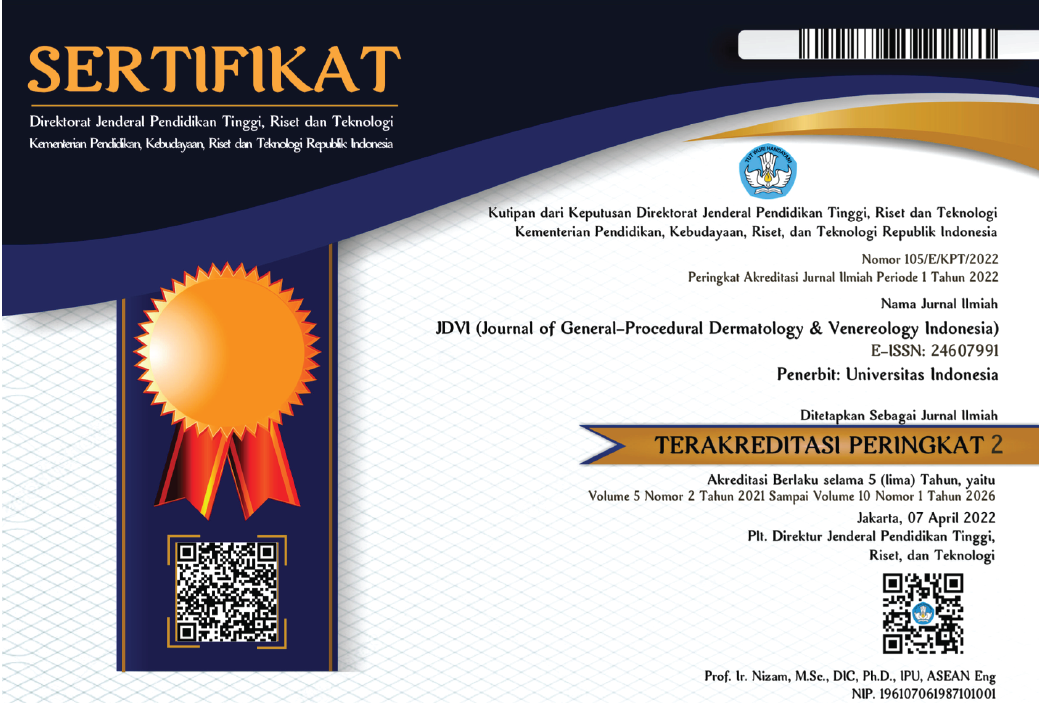Abstract
Background: Lucio phenomenon (LP) is a reaction occurring in lepromatous, non-nodular, diffuse leprosypatients who have not received multidrug therapy (MDT). The diagnosis of LP are based on clinical features and supported by histopathological examination. This report was conducted to establish a diagnosis of LP byhistopathological examination, considering that cases of LP in pregnancy are quite rare so that clinicians can be more precise.
Case: A 35-year-old pregnant woman complained of extensive ulcers on her hand and legs. Madarosis, saddle nose, and earlobes were found A slit skin smear examination showed a bacterial index of +4 and a morphological index of 20%. A skin biopsy from a leg ulcer with HE staining revealed thinning of the epidermis,foamy macrophages, inflammatory cell infiltrate in the dermis and subcutaneous layers, necrotizing vasculitis with thickening of blood vessel walls, and perivascular lymphohistiocytic infiltrate. Histopathological examination of auricular infiltrate showed basket weave type hyperkeratosis, grenz zone, lymphohistiocytic inflammatory cell infiltrates, foamy and touton cells. Histopathological examination by FF staining showed a heavy M. leprae invasion.
Discussion: Histopathological characteristics of LP in this patient found flattened epidermis, subepidermal grenz zone, aggregates and sheets of foamy macrophages admixed with predominantly huge numbers of acid-fast bacilli, foamy macrophages and touton cells. The main microscopic features also found subcutis necrotizing vasculitis. Histopathological examinations are essential to diagnose LP.
Conclusion: Histopatholgy of Lucio Phenomenon found grenz zone, inflammatory cell infiltrate and foamy cells. This histopatholgy will support the diagnosis and best treatment for LP patient.
References
- Salgado CG, de Brito AC, Salgado UI, Spencer JS. Bacterial infection : Leprosy. In: Kang S, Amagai M, Brucjner AL, et al. editors. Fitzpatrick’s dermatology. 9th ed. New York : McGraw Hill Education; 2019;p. 2892-924.
- Jurado F, Rodriguez O, Novales J, Navarette G, Rodriguez M. Lucio’s Leprosy: A clinical and therapeutic challenge. Clin Dermatol. 2015;33(1):66-78.
- Suzuki K, Akama T, Kawashima A, Yoshihara A, Yotsu RR, Ishii N. Current status of Leprosy: Epidemiology, basic science and clinical perspectives. J Dermatol. 2012;39(2): 121-9.
- World Health Organization. Weekly epidemiological record. WHO. 2018;89(36): 389-400.
- Firdaus F. Risiko keterlambatan berobat dan reaksi kusta dengan cacat tingkat 2 [in Indonesian]. J Ber Epid Airlangga. 2019;7(1):25-32.
- Widodo AA, Menaldi SL. Characteristics of leprosy patients in Jakarta. J Indon Med Assoc. 2012;62(11):423-7.
- Prakoeswa CRS, Herwanto N, Agusni RI, et al. Lucio phenomenon of leprosy LL type on pregnancy: A rare case. Lepr Rev. 2016; 87(4):526-31.
- Fogagnolo L, Souza EMd, Cintra ML, Velho PENF. Vasculonecrotic reactions in Leprosy. Braz J Infect Dis. 2007;11(3):378-82.
- Rocha RH, Emerich PS, Diniz LM, Oliveira MBBd, Cabral ANF, Amaral ACVd. Lucio’s Phenomenon: Exuberant case report and review of brazilian cases. A Bras Dermatol. 2016;91(5 Supl 1):60-3.
- Han, XY, Quintanilla M. Diffuse Lepromatous Leprosy Due to Mycobacterium lepromatosis in Quintana Roo, Mexico. J Clin Microbiol. 2015;53(11):3695-98
- Elder DE, Elenitas R, Rosenbach M, et al. Bacterial. 10th ed. In Elenitsas R, Junior BLJ., George F. Murphy GF, Xu X. editors. Lever’s Histopathology of the Skin. 10th ed, Philadelphia: Lippincots William & Walkins; 2015;p.1310-53.
Recommended Citation
Fiqnasyani, Siti Efrida; Oktavriana,, Triasari; Rosmarwati, Ervina; Novriana, Dita Eka; and Mudigdo, Ambar
(2023)
"Lucio phenomenon in pregnancy: A histopathology review,"
Journal of General - Procedural Dermatology and Venereology Indonesia: Vol. 7:
Iss.
1, Article 8.
DOI: 10.7454/jdvi.v7i1.1142
Available at:
https://scholarhub.ui.ac.id/jdvi/vol7/iss1/8
Included in
Dermatology Commons, Integumentary System Commons, Skin and Connective Tissue Diseases Commons






























